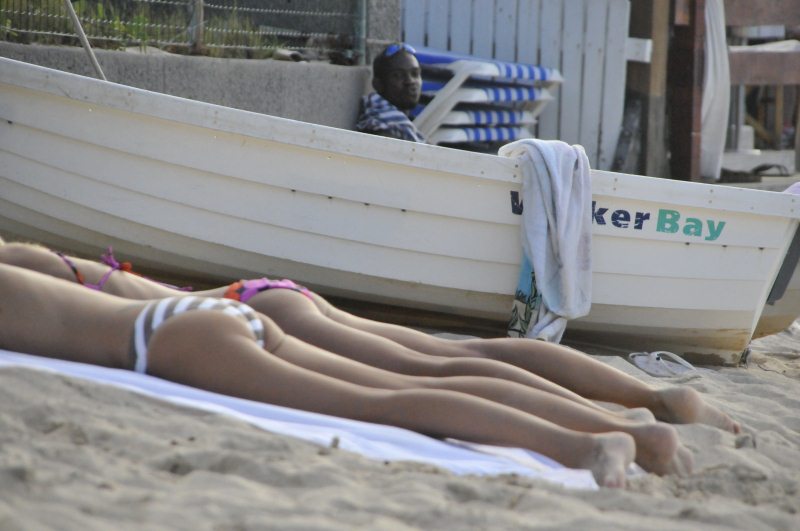St Barts

|
Saint
Barthelemy
Officially the Collectivity of Saint Barthelemy is an overseas collectivity of France. Often abbreviated to Saint-Barth
in French, or St. Barts in English, the collectivity is one of the four
territories among the Leeward
Islands in the Caribbean that comprise the French West Indies, along with Guadeloupe, Martinique and St.
Martin. St. Barts has an area of twenty four square kilometers, seven kilometers long and just three kilometers at its narrowest. The population is 8,398 (census 2006). Its capital is Gustavia, also its main harbour. It is the only Caribbean island to have historically been a Swedish colony for any significant length of time (Guadeloupe only having been one briefly, at the end of the Napoleonic Wars). The Swedish influence can still be found in architecture and street names. The language, cuisine and culture are distinctly French.

Economy: The official currency of Saint
Barthelemy is the euro. INSEE estimated that the total GDP of Saint Barthelemy amounted to 179
million euros in 1999 US$255 million at Oct. 2007 exchange rates. In that same
year the GDP per capita of Saint Barthelemy was 26,000 euros; US$37,000 at
October 2007 exchange rates, which was 10% higher than the average GDP per
capita of metropolitan France. Tourism:
St. Barts has long
been considered a playground of the rich and famous and is known for its
beautiful pristine beaches, gourmet dining in chic bistros and high-end
designers. St.
Barts has about twenty five hotels, most of them with fifteen rooms or fewer.
The largest has fifty eight rooms. Hotels are classified in the traditional
French manner 3 Star, 4 Star and 4 Star Luxe. Most of the rooms allocated to tourism on St Barts are found in private villas. There are approximately four hundred privately owned villas available for rent on the island.

Gustavia Harbour - another tick in the 1000 Places book - taken from behind the Catholic Church History: Columbus discovered the island on his second voyage in November 1493 he named it after his brother Bartholomeo. Saint Barthelemy was first claimed by France in 1648. It was given to Sweden in 1784 (in exchange for trade rights in Gothenburg), which sold it back to France in 1878. Slavery was practiced on the island under the "Ordinance concerning the Police of Slaves and free Coloured People" of 1787. The last legally owned slaves in the Swedish colony of Saint-Barthelemy were bought free by the state on the 9th October 1847. The Swedish period left its mark in the names of many of the streets and the presence of Sweden's national arms, the Three Crowns in the island's coat of arms, along with the Maltese cross, the Fleur-de-lis, the mural crown, two pelicans, and the island's supposed Amerindian name "OUANALAO".
 Geography:
Located approximately
250 km east of Puerto
Rico, Saint-Barthelemy lies near the islands of Saint
Martin, Saba
and Anguilla.
Some small satellite islets also belong to the island: Ile Chevreau, Ile
Fregate, Ile Toc Vers, Ile Tortue and Gros Ilets
Gustavia was established between 1784 and 1878, is the main town of the
island, named after King Carl Gustav
XVI of Sweden it retains the charm of the Swedish
period. The oldest settlement still remaining is the village of Lorient, Lorient's sister village on the French mainland is the city of Lorient on the southern coast of Brittany. The population is spread among a number of quartiers, roughly corresponding to settlements. The village of Corossol is known for its traditional hand-made straw objects.
Beaches: The islands beaches are among the most beautiful in the Caribbean. Most of the twenty one beaches are protected from the ocean by a coral barrier reef. All are public and free according to French Law. The beaches vary according to ocean currents - the weather travels onto the island following the sun from the East, some are enclosed and are like bath water, one is only used for surfers. St. Barts has a tidal difference of only 8–15 cm, the average yearly tropical maritime temperature is twenty seven degrees Centigrade. The beach of Grand Cul-de-Sac is the easiest beach in the Caribbean for learning sailing, windsurfing and kitesurfing as it has a reef which closes off the entire bay. The current that passes outside the reef here also carries the migrating whales and dolphins.
 Demographics: According to the January 2007 census,
the population of Saint Barthelemy is 8,450 inhabitants, white
people are in a large majority. Most of the population are
French-speaking descendants of the first
settlers. Many of the full time residents are French citizens who work at the various establishments on the island. French is the primary language spoken, the natives' languages - Patois and Creole still survive, but many residents also speak English, particularly in hotels and restaurants.
 Politics and government: Until 2007, administratively, the whole island of Saint-Barthelemy was a French commune part of Guadeloupe, which is an overseas region and overseas department of France, and therefore part of the European Union. In 2003, the population voted in favour of secession from Guadeloupe in order to form a separate overseas collectivity (COM) of France. On the 7th of February 2007, the French Parliament passed a bill granting COM status to both Saint Barthelemy and neighbouring Saint Martin. The new status took effect on the 22nd of February 2007, when the law was published in the Journal Officiel. Saint Barthelemy remains part of the European Union.
 Modelling: The tropical location and natural beauty of St. Bart's makes it a prime location for modelling photo shoots, particularly for swimwear. St. Bart's was the location of Brande Roderick's 2001 Playmate of the Year pictorial for Playboy. I hear no complaints about the views from bear.
ALL IN ALL A VERY FRENCH, WELL KEPT AND BEAUTIFUL ISLAND - BUT EXPENSIVE |
